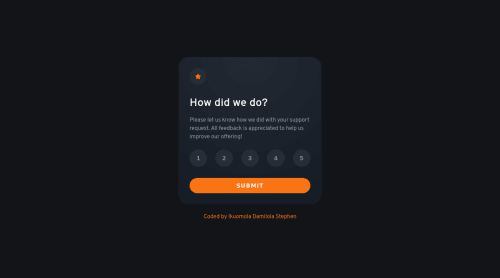Responsive Interactive Rating Component using a Mobile-First Approach

Solution retrospective
Just started learning some JavaScript and this is my crack at doing some work on my own. I got to learn a whole lot while implementing some of the features of this project. I am open to suggestions on how I could do better.
- I got to work with ES6 classes.
- I got to learn about how the DOM works and also some of the methods and properties that can be used on HTML elements.
- I also to know the difference between a Node and an Element.
- I know using Parcel might have not been necessary to use but I wanted to learn how it works.
Some questions for the community?
- Are they better ways I could have made this accessible to more users?
- Did I implement some good coding practices during the small project?
- Are the hover and active states done very well?
Please log in to post a comment
Log in with GitHubCommunity feedback
- Account deleted
Hey there! 👋 Here are some suggestions to help improve your code:
- The “icons/illustrations” in this component are purely decorative. ⚠️ Their
alt tagshould be left blank and have anaria-hidden=“true”to hide them from assistive technology.
More Info: 📚
[MDN Aria-Hidden] (https://developer.mozilla.org/en-US/docs/Web/Accessibility/ARIA/Attributes/aria-hidden#description)
- To ensure that the "rating buttons" are fully accessible 💯, they need to be built using a
form⚠️.
- Everything will be wrapped inside a
fieldsetwhich will have alegendthat is visually hidden using CSS. - Inside, there should be five
input radiosand eachinputshould have alabelattached to it to make the “ratings” accessible. - The last thing you will want to include will be a
buttonso users can submit their choice.
More Info: 📚
- Once the top is implemented , for your JS, the
eventListenershould be on theform⚠️ as asubmit.
More Info:📚
Click vs. Submit EventListeners
If you have any questions or need further clarification, feel free to reach out to me.
Happy Coding! 🎆🎊🪅
Marked as helpful - The “icons/illustrations” in this component are purely decorative. ⚠️ Their
Join our Discord community
Join thousands of Frontend Mentor community members taking the challenges, sharing resources, helping each other, and chatting about all things front-end!
Join our Discord